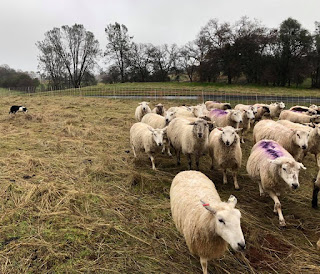I'm a planner. I suspect this part of my nature comes from my Mom. She's a list-maker (surely a type of planner). She - and I - like to think several steps ahead. This may come at cost; I sometimes envy my more spontaneous friends. When it comes to raising sheep, however, my predilection for planning has served me well.
Our production year begins with a plan that we made many years ago when we started raising sheep commercially. Fundamentally, we try to match our period of greatest forage demand (late gestation, lambing, and early lactation) with the period during which we're growing grass most rapidly on our unirrigated rangeland. Speaking more plainly, we try to lamb in late February and March, when the grass starts growing quickly. This part of our plan sets up the rest of our management calendar: we turn the rams in with the ewes in late September, which means we flush the ewes on irrigated pasture and whole grains during September. We shear the ewes about six weeks after the last lamb is born (which means mid-May). We wean the lambs after completing our first pass over our irrigated pastures (mid- to late-June).
While this overall plan rarely changes much from one year to the next, our annual grazing plans reflect the year-to-year variation in weather. Some years (like the fall/winter of 2016-2017) are easy - we get early rains and a warm autumn, resulting in more grass than we know what to do with in December and January. Some years, like this one, are more difficult from a grazing planning perspective. We had a germinating rain in early October 2018 (which was great), but no more rain until Thanksgiving (which was not). Since we didn't have much volume of green grass in December, we fed the ewes supplemental protein (an added expense), which allowed them to digest the dry grass we'd saved from spring. Now that the green grass is coming, we still don't have the volume we enjoyed 2 years ago - which means we're moving the sheep a bit more frequently.
The other part of our year-to-year planning has to do with lambing preparations. We lamb on pasture (unlike some sheep producers, we do not bring all of the lambing ewes into a barn at or just after lambing). Our plan begins with selecting ewes that can handle lambing on pasture - ewes that can give birth unassisted, that know how to count to 2 or 3 (meaning they'll take care of all of the lambs they deliver), that seek natural shelter (like brush or topography) in which to give birth. But we don't rely entirely on the ewes' instincts; we also plan our winter grazing to save our more sheltered rangeland for lambing. This means we graze the more exposed pastures in January and early February - pastures without much tree or brush cover, or that are facing the prevailing southerly winds we get during storms in the Sierra foothills. We have more flexibility to move sheep before they've lambed - dry ewes are much easier to move than pairs (ewes with lambs). Before lambing, we can easily move them (with the help of a border collie or two) from one end of our winter country to the other (as I did today); once the lambs begin arriving, we try to drift the flock gently from one paddock to the next.
Given my genetic predisposition to planning, I'll admit that I enjoy this mental aspect of shepherding nearly as much as the physical work. I find the work involved in raising sheep (building fence, herding the flock in partnership with my dogs, watching our finished lambs get on the trailer) intensely satisfying. I also find the work of planning - of estimating our forage needs, of preparing for lambing (or shearing or weaning), of selecting the right replacement ewe lambs for our flock - to be equally satisfying.
Lambing begins in about 18 days - stay tuned for the results of this year's planning efforts!





No comments:
Post a Comment